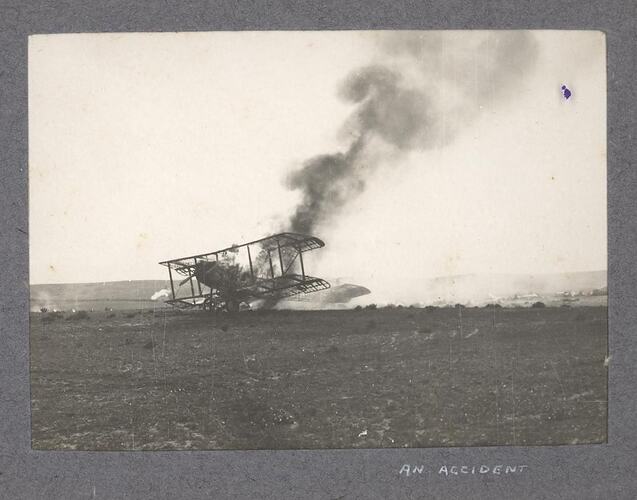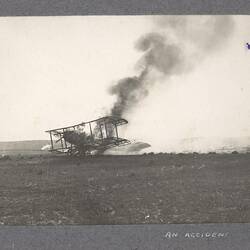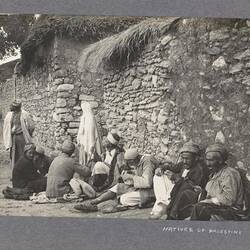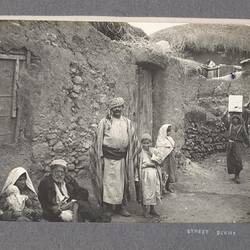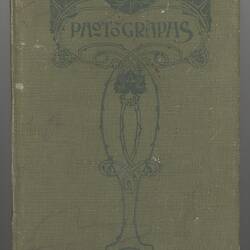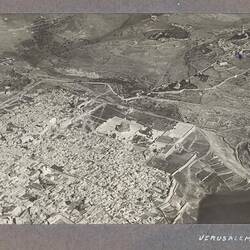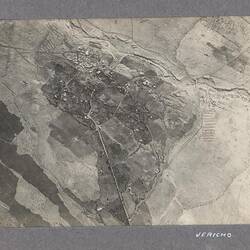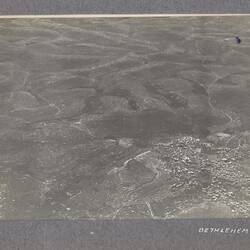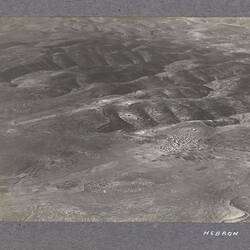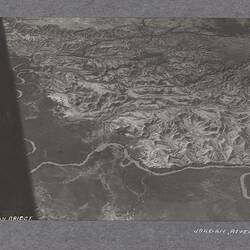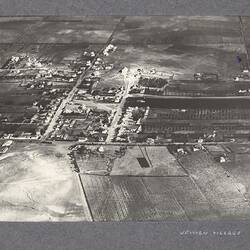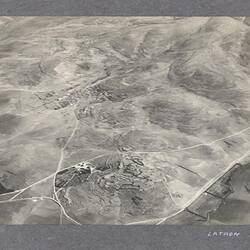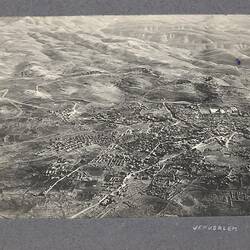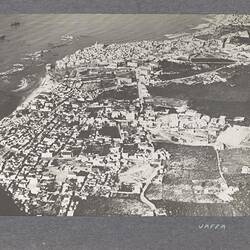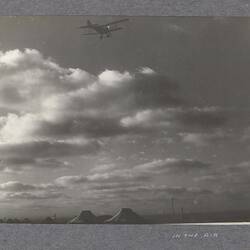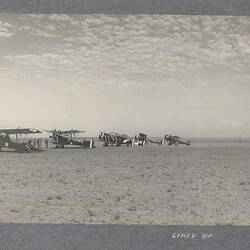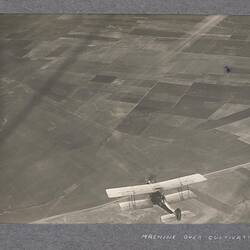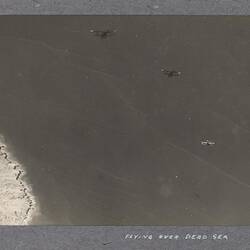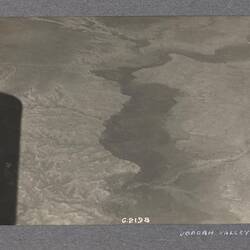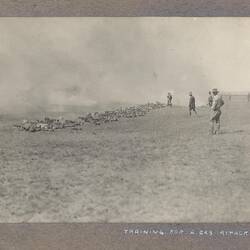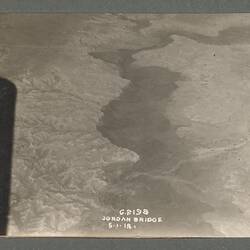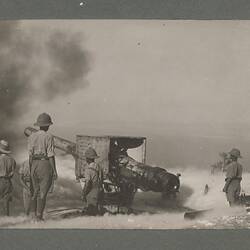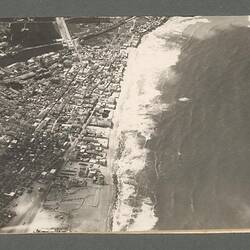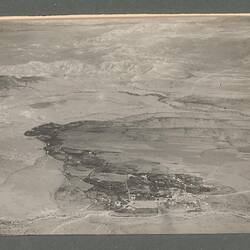During independent research into the Sinai Palestine Campaign of 1918, James Brew accessed the photograph albums compiled by Norman Henry Clutterbuck using the Museums Victoria's collections online. In reviewing the albums he concluded that they had significance for a variety of reasons including the fact that they possibly held photos from the famed Australian photographer Frank Hurley. The following article is based on research from various other archives that establish how the albums were compiled utilising official reconnaissance photos and Frank Hurley's. In doing so, the article places the Clutterbuck albums within the context of the AFC in the Middle East in World War I.
The Clutterbuck photograph albums held at Museums Victoria (ST 41220 and ST 41221), provide a unique insight into the Sinai Palestine Campaign of 1918, and to the growing role of photography in not just monitoring activity on the ground but in informing and influencing military strategy.* Aided by the inclusion of images taken by famed Official Australian War Photographer Captain Frank Hurley, the Clutterbuck Collection reflects a crucial period of evolution in military photography that would influence later campaigns involving Australian forces.
During the Sinai Palestine Campaign of 1917-1918 Corporal and Air Mechanic Norman Henry Clutterbuck from Geelong, Victoria, was a member of the Photographic Section of the Number One (No. 1) Squadron, Australian Flying Corp (AFC), Australian Imperial Forces (AIF).(1) The role of No. 1 Squadron was to ensure command of the air, attack enemy land targets and undertake photographic reconnaissance.
Although his official designation was 'Air Mechanic (Photographer)', the title did not have the contemporary meaning of someone who takes photographs. Rather, the role of Corporal Clutterbuck and his colleagues in the Photographic Section was to process photographic plates that had been taken by the pilots and observers during operational sorties (patrols) over enemy (in this case Turkish) lines. By war's end the Photographic Section of No. 1 AFC had exposed 5,935 photographic plates that had been taken during 565 reconnaissance flights. From these, the Photographic section produced 51,356 prints.(2) These prints were distributed directly to various Headquarters, frontline units and to the 7th Survey Company, Egyptian Expeditionary Force (EEF) for the making and updating of maps.(3) Consequently, the Photographic Section of No.1 Squadron, AFC, had a critical role in the chain that led from the demand for information from frontline units, to aerial photography and the distribution of photographic prints for use by the entire EEF. The Clutterbuck albums held at MuseumsVictoria are important because they have preserved photographs from critical moments of the Sinai Palestine Campaign of 1918 into a single collection.(4)
The collection, however, does not only include reconnaissance photos. The albums are enhanced by the inclusion of photographs taken by, or in coordination with, the Australian Official War Photographer, Captain Frank Hurley, who captured a far greater narrative in his images, conveying the military and operational context of the Sinai Palestine Campaign. Through the lens of No. 1 Squadron AFC and the curation of these albums to include additional contemporaneous images such as Hurley's, Clutterbuck has provided a unique narrative of the progress of the Sinai Palestine campaign as undertaken by the first operational squadron of what became the Royal Australian Air Force (RAAF).
In the No. 1 Squadron AFC War Diaries of 1918, there is no record of Clutterbuck flying on operations or on test flights.(5) Clutterbuck's role was to process film that was taken during the flights In the flight logs of reconnaissance and photographic sorties the names of pilot and observer are given for each flight. AFC officers crewed the planes, took the photographs and returned the film to the Squadron's Photographic Section for processing and distribution. The exception to this rule was for Official Australian War Photographer, Captain Frank Hurley, who is logged as flying with No.1 AFC on 15, 16 and 25 February 1918.(6) In his diary, Captain Hurley describes in detail these flights taken over Palestine, including Jerusalem, Beersheba, the Dead Sea and an attack on Karak, Jordan, on 25 February.(7) Hurley, uniquely in that no other moving pictures were taken and he was experimenting with cinema film at the time, took film of these flights.(8) The aerial photographs in Clutterbuck's albums of, for example the squadron flying over the Dead Sea, correspond with the destinations that Hurley flew to during his flights. Although none of the photographs within the Clutterbuck albums are likely to have been taken by Clutterbuck, he was in a unique position to collect photographs that were developed by the Photographic Section.
The Clutterbuck albums tell the story of the Palestine campaign from the Second Battle of Gaza in March 1917 to the end of the campaign in Syria in October 1918.(9) This is period when photographic reconnaissance became increasingly in demand for surveying and mapping purposes.(10) The first requests for reconnaissance photos were for images of key towns and villages.(11) The demand for photographic intelligence led to an evolution in the role of strategic reconnaissance by the AFC from observing the movements of the Turks to the supply of photographic evidence of Ottoman troop movements, systems of supply, and quality of defence and infrastructure. The photographs produced throughout 1918 reflect the changing demand emanating from the EEF as it attempted to advance against the Turkish and German forces through Palestine.(12) Concomitantly the collection and analysis of photographs also led to advances in deception techniques that were used prior to the decisive Battle of Megiddo in September 1918. In the final weeks and days of the war the photographs provided real time information to EEF commanders on the disintegration of the Ottoman armies.
The perspective of the Clutterbuck albums, however, is not a purely military one. The Clutterbuck photographs also provide an insight into the life of Palestinian villagers. This interaction was a dominant theme, whether positive or otherwise, of all those who fought in the Sinai Palestine campaign. With the inclusion of photographs of No. 1 Squadron on the ground, the albums reflect the life of an operational squadron, albeit in a very limited way. There are no portraits of Clutterbuck's colleagues, for example, although we do get glimpses of the planes set out for an inspection. In the Clutterbuck albums there is a photo of a burning plane titled 'An Accident'. This same incident is used in a photo exhibited by Hurley in his 1919 exhibition of war photographs held at the Grafton Gallery in Sydney. Hurley also mentions this incident in his diary. When looked at side by side, it is clear that the photos are of the same accident by from slightly different angles. The difference of a few steps for the photographer. When the context of the photos is understood then the unique perspective that they provide of the Palestine campaign emerges.
Throughout his service with the AFC, Corporal Clutterbuck worked closely with famous Australian aviators such as Sir Ross Smith who, after World War I, set global aviation records and Sir Hudson Fysh, a founder of Qantas Airways. During World War I, both Smith and Fysh were officers flying with No.1 Squadron AFC. Similarly to Corporal Clutterbuck, Sir Hudson Fysh compiled an album of photographs taken during World War I.(13) Whereas Clutterbuck's photos provide insights into various aspects of the Palestinian campaign, Fysh's collection is strictly a selection of reconnaissance photos from important moments of the campaign from a military perspective - some of which he was a direct participant in, having flown on the days the photos were taken. Many of the photos in the Hudson Fysh collection are exactly the same as Clutterbuck's. In turn, both the Clutterbuck and Fysh collections share photos with those in the AFC Official War Diaries kept throughout 1918. In some instances the numbered photographs add to the sequencing within the War Diaries thus providing a fuller representation of the subject under review. This indicates that the photographs were perceived by photographer, aircrew and squadron staff to be of particular relevance to the outcome of the campaign.
Captain Frank Hurley was responsible for taking many of World War I's iconic photographs. Prior to his enlistment Hurley had participated as the photographer in Sir Ernest Shackleton's Imperial Trans Antarctic Expedition. Hurley was marooned with this expedition in Antarctica from February 1915 - August 1916. By 1918, the Shackleton expedition and the work that Hurley had already completed in France during 1917 had made him a celebrity to the Australian forces in Palestine. Although he was a recognized commercial photographer, photos taken in his role as an Official War Photographer were the property of the Australian government. According to Hurley's diary the AFC extended every courtesy to him.(14) This included being taken on reconnaissance flights and a bombing run to the east of the River Jordan. Although Hurley does not mention spending time with the No. 1 Squadron Photographic Section, when departing Egypt in March 1918, as a precaution against loss due to a potential submarine attack, he deposited all of his prints with the Australian War Records (AWR) office. It is likely, therefore, that he utilized the offices of the Photographic Section of No. 1 AIF to develop his photographic plates and to make prints from the same. With the Clutterbuck albums having copies of official reconnaissance photos it is reasonable to assume that Corporal Clutterbuck wished to include photographs from such a notable photographer as Hurley in his albums. Comparisons with Hurley's photos and those of Clutterbuck, the timing of Hurley's arrival, and the relationship between their professions, demonstrate that the Clutterbuck albums hold some Hurley photos.
In the Clutterbuck album (15), the photo titled 'An Accident' is of a Martinsyde plane burning. In his diary entry of 15 February 1918, Hurley noted the incident. 'Just before lunch we observed a machine land with smoke issuing from near the pilot's seat. He had only just time to jump out when the machine burst into flame and was speedily demolished. Fortunately I had both Cinema and camera at hand and secured some unique pictures.'(16) In Hurley's personal photo album the photo of the burning plane is titled 'Machine that landed in flames - Palestine'.(17) There appears to be a slight variation of the angles between the photos in the Clutterbuck and Hurley Albums. This is consistent with Hurley's diary where he took 'some unique pictures'. In his diary entries Hurley rarely makes reference to specific photographs. He does, however, note his experiments with technique or a location. This burning plane incident was one that he clearly considered special. Hurley featured the burning plane photograph in his Exhibition of War Photographs held in Sydney in 1919. In this exhibition he had re-titled the photo as 'Brought Down in Flames'. Other photos in the Clutterbuck albums are consistent with Hurley's work with No. 1 AFC in formation flying, reconnaissance and a bombing mission to Kerak to the east of the River Jordan.
Assuming that Hurley did indeed make use of the Photographic Sections to develop his images, it does not take much additional extrapolation to assume some of his images, or duplicates of them, made it into Clutterbuck's hands at this time. In the Clutterbuck collection, for example, the photo titled 'Aerodrome'(18) is shared in the Fysh collection. This photo was included by Hurley in the London Exhibition of 1918 titled 'A machine descending to the hangers of the 1st Australian Flying Corps, Palestine'.(19) It is probably that an original print of the photo was collected by Clutterbuck and Fysh. It is also possible that Hurley superimposed on his original photo a landing airplane in what was the controversial practice of creating a 'composite photo' from two separate images.(20) The Clutterbuck and Fysh 'Aerodrome' print was taken at the No. 1 Squadron airfield at Mejdel, Palestine. Many of the aerial and ground shots in the Clutterbuck collection reflect Hurley's framing for his colour Paget's (i.e. an early colour photography process), composites or black and white photographs. Moreover, Hurley took several ground-level photographs at Mejdel airfield from different perspectives. Similar photos are included in the Clutterbuck albums. Few of these, however, are of the standard later exhibited by Hurley such as those taken during the visit of Lieutenant General Sir Henry Chauval, Commander of the Australian Mounted Corp (AMC) on 24 February 1918. Hurley, it seems, took with his best photographs with him when he left Egypt for London in March 1918.(21) Finally, during his stay with No. 1 Squadron, Captain Ross Smith was Hurley's pilot. They remained friends following the war. In a letter to his mother dated 29 March 1918, Smith wrote '(T)he enclosed photos are some Capt. Hurley took. Don't let any newspaper people see them!' (22) It seems that not only were his photos printed by the No. 1 Squadron Photographic Section but also that Hurley, or the Photographic Section, copied his images and shared them as mementos. Consequently, both Clutterbuck and Fysh added to their collections at the same time.
Hurley, as both a professional photographer and artist, was constantly experimenting with angle, light and colour. In his personal photo albums held at the State Library of New South Wales (SLNSW), the selection is what he may have considered as his best wartime photos.(23) These photos are primarily those that he exhibited in London (24) in 1918 at Australia House and later in Melbourne and Sydney in 1919.(25) A comprehensive collection of Hurley's photos (over 10,000), however, are held at the State Library of New South Wales.(26) In reviewing these, it is clear that not all are of superior quality and many, it seems, were used for scoping, ranging and experimenting. Within these photos there are several portraits, streetscapes and landscapes. Similar types of photographs are found in Clutterbuck's collection. For example, within the Clutterbuck collection there are two photographs taken from the vantage of a village street. This village is likely the village of Mughar. Hurley visited this village twice and took coloured and black and white photographs.(27) The two photos titled 'Natives in Palestine' (28) and 'Street Scene' (29) are, possibly, intended to be viewed as a single panorama shot. There is evidence within his collection held at the State Library of New South Wales (SLNSW) that Hurley took photos with the intent of joining them in this manner. Consequently, it is likely that the Clutterbuck albums contain not only Hurley photos but also add context to some of Hurley's better-known pictures taken in Palestine with Australian forces in World War I.
For his work with the Photographic Section, Corporal Clutterbuck was Mentioned In Dispatches (MID) by General Allenby, the commanding general of the EEF. This entitled him to wear a clasp of oak leaves on his Victory Medal. Following his return to Australia in 1919, Corporal Clutterbuck remained with the AFC. He became a Flying Officer based at Point Cook, Victoria where No. 1 Squadron, then AFC, was based. Flying Officer Clutterbuck's role was to instruct what would become the World War II generation of photographers. Ultimately, the approach learned in Palestine in World War I was to have an impact on Australia's campaigns in New Guinea and in the Middle East.
The photographs that Clutterbuck collected during the Sinai Palestine campaign of World War I were curated by him to illustrate poignant episodes such as the battle of Gaza, the crossing of the River Jordan at Ghoraniyeh Bridge and the Battle of Megiddo. The collection also tells of the arrival of Frank Hurley and how important it was to have such a famed photographer (and cinematographer) visit No. 1 Squadron AIF, enabling them to tell their story to the outside world through film. Both the Hurley photos and the Fysh reconnaissance photos that are also in the Clutterbuck albums were sufficiently well curated by Clutterbuck that they were also included in the Official History of Australian in the War of 1914-18 in Vol. 7 Sinai and Palestine and in Vol 12. Photographic Record of the War.(31) Finally, the Clutterbuck collection touches on the ground level view of the squadron and the local people that surrounded it.
The collection is curated by a man who, perhaps aware of his own limitations with a camera, was technically interested in photography and proud of his role and that of his Squadron in the conduct of the war in the Sinai Palestine campaign. Ultimately, in so sparsely adding narration to the albums, Clutterbuck has let the images tell the story of the war as he and his colleagues experienced it, while also telling a story about the importance of wartime photography.
* This article was first published in Aerogram, the Jornal of the Friends of the RAAF Museum, September 2020, pp. 31-37, and is reproduced with permission.
References
1. Australian War Memorial photo: https://www.awm.gov.au/collection/C41703
2. AIF War Diary; Australian Flying Corp; No. 1 Australian Flying Corp. War Diary February 1919, AWM.
3. F.M. Cutlack; The Australian Flying Corps in the western and eastern theatres of war 1914-1918, Official History of Australia in the War of 1914 -1918, vol. VIII, pg. 113, Sydney: Angus and Robertson, 1923.
4. https://collections.museumvictoria.com.au/search?name=Mr+Ray+(Raymond)+V.+Kerby
5. AIF War Diary; AFC, No. 1 Squadron, War Diaries Jan 1918 - Feb 1919, AWM.
6. AIF War Diary; AFC, No. 1 Squadron War Diary February 1918 Part 3, AWM.
7. Hurly, Frank; My Diary. August 1917 - August 1918, Feb. 13th - March 1st, NLA.gov.au
8. https://aso.gov.au/titles/historical/australian-flying-corps-france/clip3/
9. N.B. The photo titled 'Coastal Defence Gun Firing' is less easy to determine. The possibilities range from coastal defence of the Suez Canal to a captured weapon at GAZA. Given the similarity to the photo of the Tank, this photo may have been taken at approximately the same time period from the Second to Third battles of Gaza in April and October 1917 respectively.
10. Sheffy, Yigal; British Military Intelligence in the Palestine Campaign 1914-18, pp. 305, Frank Cass & Co., London, UK, 1998.
11. Gavish, D., Biger. G; Innovative Cartography in Palestine of 1917-1918 Initial Use of Aerial Photography in Town Mapping, pp. 81-91, Published Online, www.tandfonline.com, 19th July 2013,
12. F.M. Cutlack; The Australian Flying Corps in the western and eastern theatres of war 1914-1918, Official History of Australia in the War of 1914 -1918, vol. VIII, pg. 93, Sydney: Angus and Robertson, 1923
13. Fysh; Sir Hudson; Aerial Photographs of Palestine in 1918, State Library of NSW, https://collection.sl.nsw.gov.au/item/1Jkm85xY#NNV5NPzMpX20K
14. Hurly, Frank; My Diary. August 1917 - August 1918, NLA.gov.au
15. Clutterbuck album ST41221
16. Hurley, Frank; My Diary. August 1917 - August 1918, pp. 133-134, NLA.gov.au
17. http://digital.sl.nsw.gov.au/
18. ST 041221, Photograph Album - Middle East, World War I, 1916-1919 (MILITARY HISTORY), Object, Registered, Photo No. MM 114554.
19. https://www.sl.nsw.gov.au/stories/frank-hurleys-world-war-i-photography/i-want-jerusalem-christmas
20. https://www.sl.nsw.gov.au/stories/frank-hurleys-world-war-i-photography/truth-and-photography
21. Hurley had copies made of his prints prior to embarking for London in case there was a submarine attack. On May 25th an exhibition of his war photography, including those of the Palestine Front, were held at Australia House. Hurley; F; My Diary August 1917 - August 1918,nla.gov.au
22. https://digital.collections.slsa.sa.gov.au/nodes/view/6273?keywords=palestine%201918&all=1&whole=2
23. http://archival.sl.nsw.gov.au/Details/archive/110320909
24. https://s3-ap-southeast-2.amazonaws.com/awm-media/collection/AWM2017.7.326/bundled/AWM2017.7.326.pdf
25. http://archival.sl.nsw.gov.au/Details/archive/110320909
26. https://www.sl.nsw.gov.au/learning/schools-and-teachers/frank-hurley-collections
27. Hurly, Frank; My Diary. August 1917 - August 1918, pp. 133-134, NLA.gov.au
28. Museums Victoria MM 113599, Photograph - 'Natives of Palestine', Middle East, World War I, 1916-1918
29. Museums Victoria MM 113600, Photograph - 'Street Scene', Middle East, World War I, 1916-1918
30. Australian War Memorial Photo: https://www.awm.gov.au/collection/C1283115
31. Official History of Australia in the War of 1914-18, Vol. VII Sinai & Palestine; Official History of Australia in the War of 1914-18, Vol. XII Photographic Record of the War.
More Information
-
Keywords
-
Localities
-
Authors
-
Article types
